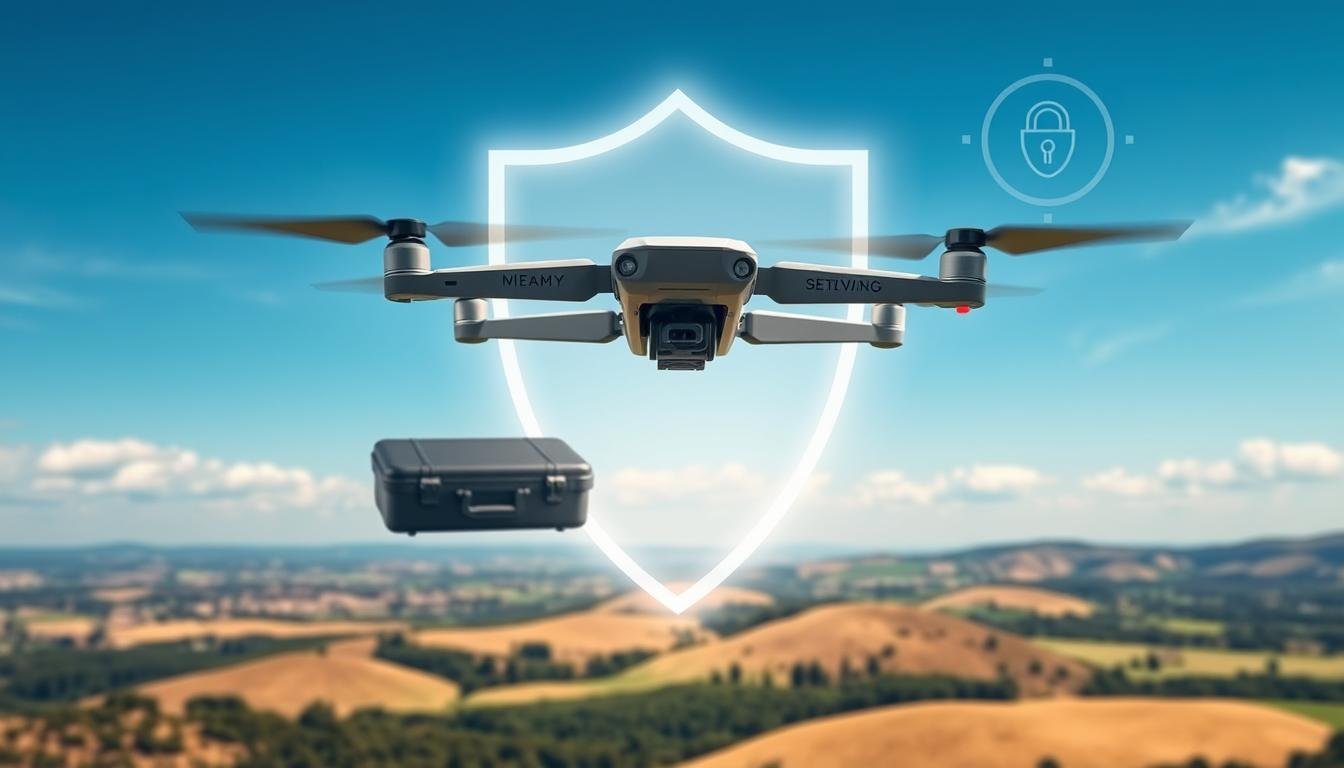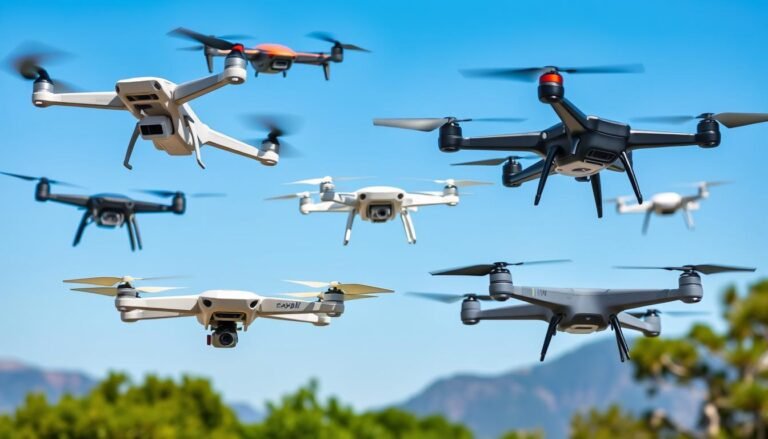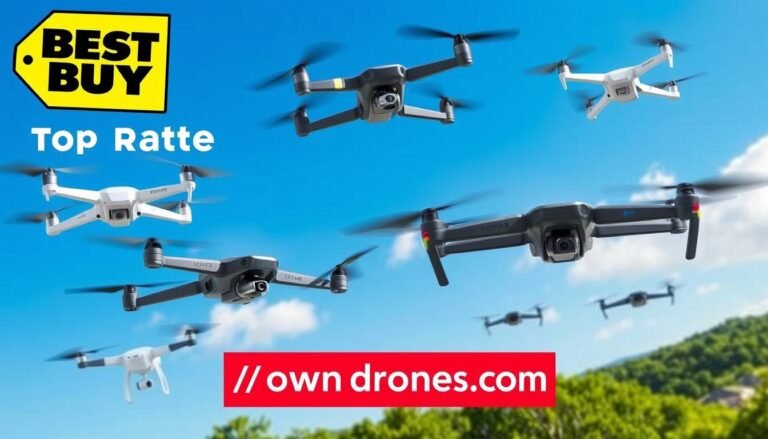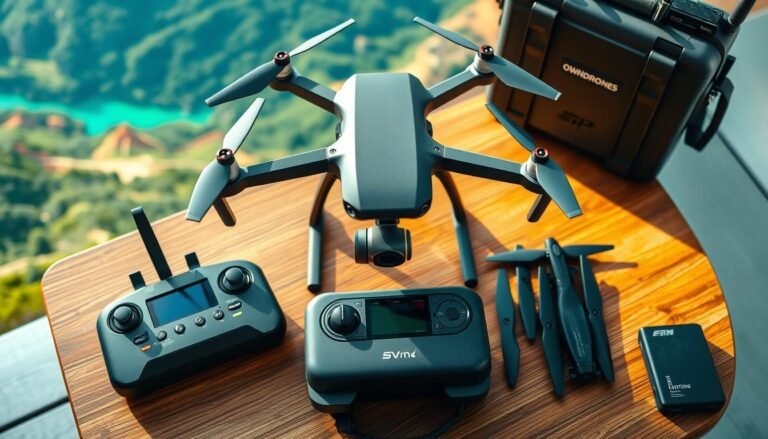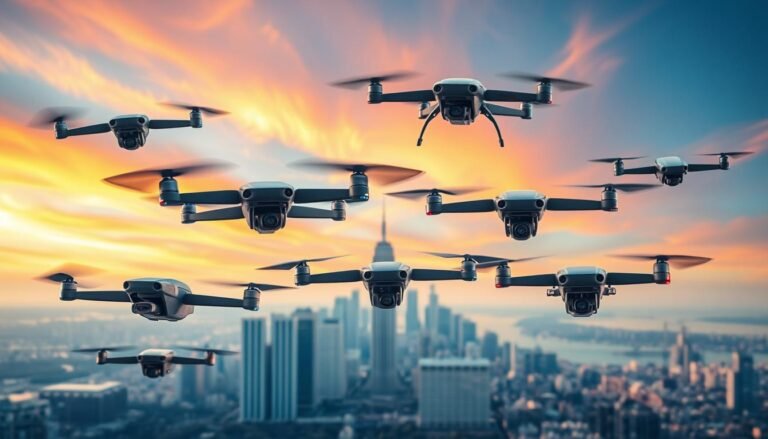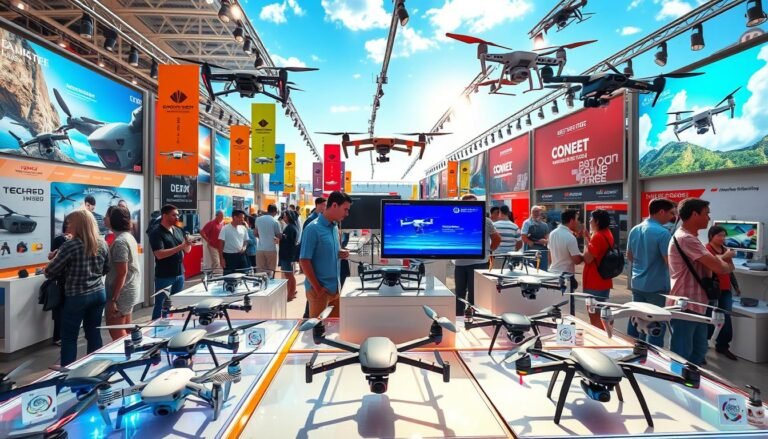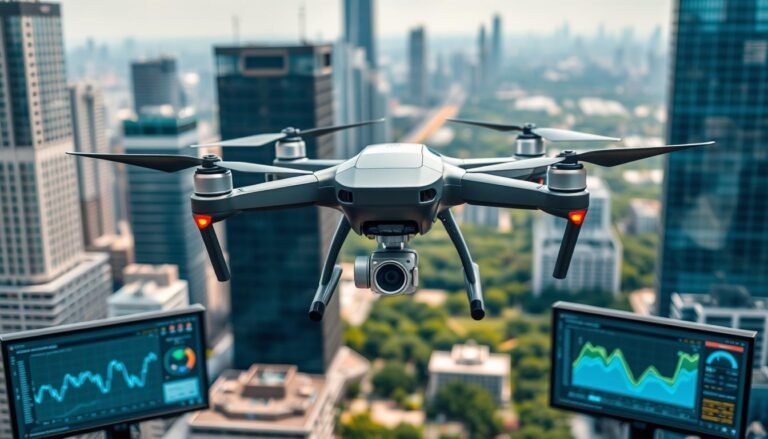Drone Insurance: Protect Your UAV Investment Today
Flying drones comes with risks and liabilities. Protecting your investment and financial well-being is crucial. Drone insurance offers a safety net for pilots.
It guards against accidents, property damage, and legal claims. This coverage is vital for hobbyists and commercial operators alike. The demand for comprehensive drone insurance is growing rapidly.
The global drone insurance market will reach $2.6 billion by 2032. This shows how important it is to protect these assets. Various policies are available to meet your needs.
Hull insurance covers physical damage to your drone. Liability insurance protects you from third-party claims. These policies offer financial protection and peace of mind.
We’ll explore drone insurance options, premium factors, and tips for choosing providers. We’ll also discuss legal and regulatory compliance for commercial drone operations. You’ll learn how insurance can protect your investment and boost your confidence.
Key Takeaways
- Drone insurance is crucial for protecting your UAV investment and mitigating potential risks and liabilities.
- The global drone insurance market is projected to reach $2.6 billion by 2032, highlighting the growing demand for comprehensive coverage.
- Different types of drone insurance policies include hull insurance for physical damage, liability insurance for third-party claims, and payload insurance for cameras and sensors.
- Factors such as drone value, intended use, and pilot experience can affect drone insurance premiums.
- Choosing the right drone insurance provider involves comparing coverage options, evaluating customer support, and considering policy flexibility.
Why Drone Insurance is Essential for Every Pilot
Drone insurance is vital for all pilots, hobbyists and professionals alike. It protects against risks and liabilities, safeguarding your investment. Drone insurance acts as a safety net, safeguarding your investment and offering peace of mind in the event of accidents, malfunctions, or property damage.
Liability Protection and Peace of Mind
Drone insurance protects you from liability claims. If your drone causes damage or injury, you could be held responsible for expenses. Insurance covers such scenarios, shielding you from potential financial hardship.
This is crucial when flying near populated areas or sensitive infrastructure. The risk of accidents is higher in these locations. Commercial drone liability insurance typically starts at $500-$1,000 per year for $500,000-$1 million in coverage.
Costs can increase based on the risk level of your drone operations. Work with reputable providers to find a policy that fits your needs and budget.
Safeguarding Your Drone Investment
Drone insurance also protects your equipment investment. Accidents or malfunctions can lead to costly repairs or total loss. Hull insurance, covering physical damage, typically costs 8-12% of the drone’s value per year.
Comprehensive insurance plans provide peace of mind against unexpected expenses. Many clients now require drone operators to carry insurance for commercial projects.
A commercial drone operator experienced a technical malfunction resulting in an accidental damage claim paid by their insurance, highlighting the importance of comprehensive coverage.
Having proper insurance coverage shows your professionalism and readiness to handle risks. This sets you apart from competitors who may not be adequately insured.
Understanding the Different Types of Drone Insurance Coverage
Protecting your drone investment requires understanding various insurance options. Drone insurance offers tailored coverage for pilots and their unmanned aerial vehicle (UAV) needs.
Hull Insurance for Physical Damage
Hull insurance covers physical damage to the drone itself. It typically costs 8-12% of the drone’s value per year. Insurance companies consider the depreciated value, not market value, when settling claims.
Avoid inflating your drone’s value when purchasing insurance. This ensures you get appropriate coverage without overpaying.
Liability Insurance for Third-Party Claims
Liability insurance protects pilots against claims for harm or damage to others or their property. Coverage starts from $500 to $1,000 yearly for $500,000 to $1 million in protection.
Some clients request a Combined Single Limit (CSL) for liability coverage, starting from $5 million. The industry minimum recommended liability coverage is $1 million.
Payload Insurance for Cameras and Sensors
Payload insurance covers specialized equipment attached to the drone, like cameras or sensors. It’s crucial for protecting expensive gear used in aerial photography and surveying.
Some policies cover ground equipment used to control the drone. They may also include personal injury coverage for issues like libel or privacy violations.
Consider coverage limits, deductibles, and exclusions when selecting a drone insurance policy. Think about your specific needs based on how you’ll use the drone.
Commercial drone pilots may face higher premiums than recreational users. Many customers require pilots to have insurance, which can affect hiring decisions.
The drone industry is growing rapidly, with thousands of drones in operation. Protecting your UAV with the right insurance is more important than ever.
Factors Affecting Drone Insurance Premiums
Several factors impact the cost of your drone insurance premiums. Knowing these can help you make smart choices and save money. Let’s explore the key elements that shape your drone insurance costs.
Your drone’s type, use, and value influence insurance prices. High-end drones with advanced features usually cost more to insure. Commercial UAV insurance is pricier than recreational due to higher risks.
Pilot experience is crucial for insurers when calculating premiums. A good flying record can lead to lower costs. It shows you’re a safer pilot.
Frequent drone use raises accident risks and may increase insurance costs. The coverage limits you pick also affect your premiums. Higher deductibles can reduce costs, but balance is key.
Assessing risks helps determine proper coverage for your drone operations. Your location impacts insurance premiums too. Some U.S. states have specific drone insurance rules affecting costs.
| State | Annual Drone Insurance Cost Range |
|---|---|
| California | $600 – $1,200 |
| Georgia | $500 – $1,000 |
| Texas | $550 – $1,100 |
| Florida | $600 – $1,300 |
The table shows yearly drone insurance costs in different states. It highlights how location affects prices. Consider these factors to find the best drone insurance for your needs.
Choosing the Right Drone Insurance Provider
Selecting the right insurance provider is vital for protecting your drone investment. Compare coverage, premiums, and customer support to find the best fit. Assess your specific requirements and risks as a drone pilot.
Consider your drone type, intended usage, and experience level. These factors help determine the appropriate coverage for your situation.
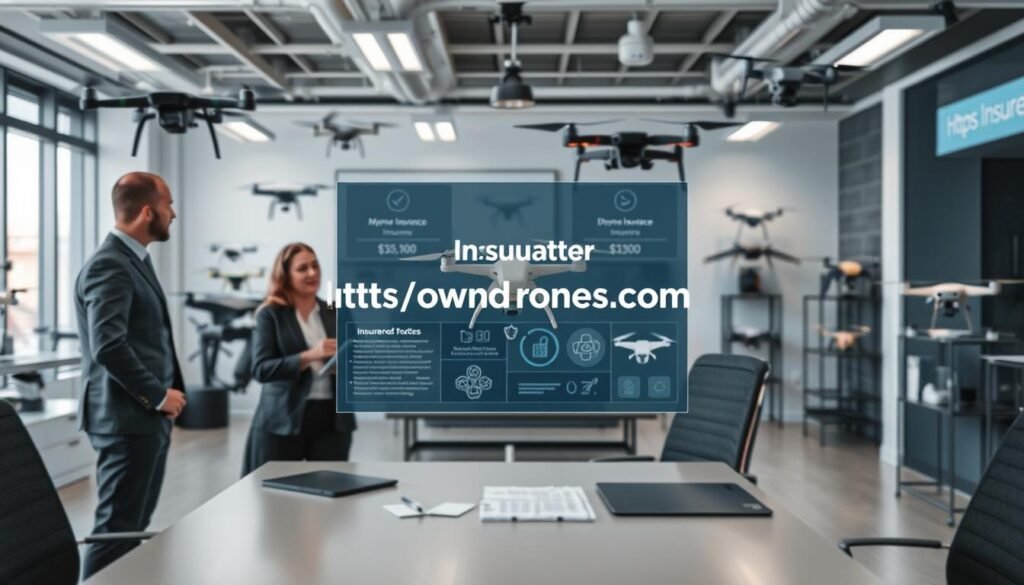
Comparing Coverage Options and Premiums
Research and compare drone insurance quotes from multiple providers. Look for comprehensive coverage, including protection against accidental damages and third-party liabilities. Seek policies that offer payload and transit coverage.
Premiums vary based on drone model, usage, pilot experience, and coverage limits. Consider both annual policies and short-term options for infrequent flyers.
| Coverage Type | Low-Risk Operations | High-Risk Operations |
|---|---|---|
| Liability Coverage | $1 million – $3 million | $3 million – $5 million |
| Hull Insurance | Cost of replacing drone | Cost of replacing drone |
Evaluating Customer Support and Claims Processing
Assess the customer support and claims processing efficiency of potential drone insurance providers. Look for providers with responsive service and timely claims handling. Read reviews from other drone pilots to gauge their experiences.
I had a smooth experience with my drone insurance provider when I needed to file a claim. Their customer support was helpful, and the claim was processed quickly.
Carefully consider coverage options, compare quotes, and evaluate customer support. This approach helps find the right provider to protect your investment. You’ll gain peace of mind while flying your drone.
Drone Insurance Policy Types
The drone industry is booming, with nearly one million registered drones in the U.S. Drone insurance policies are vital for protecting these aircraft. The FAA classifies drones as aircraft, making proper coverage essential.
There are two main types of drone insurance policies: liability-only and comprehensive coverage. Liability-only insurance protects pilots against third-party claims for property damage or bodily injury. Comprehensive coverage includes both liability and physical damage protection for the drone.
Short-term and on-demand drone insurance options offer flexibility for infrequent flyers. These policies allow operators to insure their drones for specific periods or by the hour. This ensures necessary coverage when it’s needed most.
Several factors impact insurance premiums when choosing a policy. These include drone type, intended usage, pilot experience, and required coverage limits. Considering these elements helps find the right policy.
| Policy Type | Coverage | Ideal For |
|---|---|---|
| Liability-Only | Third-party claims (property damage, bodily injury) | Pilots with low-risk operations or limited budgets |
| Comprehensive | Liability and physical damage to the drone | Pilots seeking complete protection for their investment |
| Short-Term/On-Demand | Customizable coverage for specific periods or hours | Infrequent flyers or those with varying insurance needs |
The drone industry is constantly changing. Pilots must stay informed about new regulations and insurance requirements. Adapting coverage needs helps ensure adequate protection and risk mitigation.
Navigating Drone Insurance Requirements for Commercial Operations
Commercial drone pilots face complex insurance requirements. The right coverage protects your business and ensures legal compliance. It’s vital to understand what clients and employers expect.
Commercial drone operations require specific insurance. Clients often demand higher liability limits or extra coverages. Review their requirements carefully to ensure proper protection.
Meeting Client and Employer Expectations
Different clients have varying insurance needs. Some want higher liability limits, others need specific coverages. It’s crucial to discuss these before accepting a job.
Review the requested coverages and limits. Get additional insurance if needed. Always provide proof of insurance to clients and employers.
- Discuss insurance requirements with clients before accepting a job
- Review and understand the specific coverages and limits requested
- Obtain additional insurance or increase limits as needed
- Provide proof of insurance to clients and employers
Complying with Legal and Regulatory Mandates
Commercial drone pilots must follow legal insurance requirements. Stay informed about local and federal drone regulations to avoid penalties. Compliance is key.
- Research and understand the insurance requirements for commercial drone operations in your area
- Ensure your insurance policy meets the minimum legal requirements
- Stay up-to-date on changes to drone flight regulations that may impact insurance needs
- Maintain accurate records of your insurance coverage and flight operations
Address insurance needs proactively to protect your business. Comprehensive commercial drone insurance safeguards your assets. It also shows professionalism and reliability to clients and employers.
Tips for Reducing Drone Insurance Costs
Drone insurance protects your investment and reduces risks. The cost depends on factors like drone type, usage, pilot experience, and coverage limits. Let’s explore ways to lower your premiums without sacrificing coverage quality.
Maintaining a long, accident-free flying history can significantly reduce insurance costs. Insurers often reward safe and professional pilots with better rates. Investing in reputable training programs can enhance your skills and show your commitment to responsible operation.
Choose insurance coverage that aligns with your specific needs. Some policies cover operations beyond line of sight or night flights. Tailoring your coverage to your requirements helps avoid paying for unnecessary features.
Compare quotes from different drone insurance providers to get the best value. Negotiate with insurers by discussing your safety record, training, and experience. Remember, insurance is a small price compared to potential financial and legal consequences.
| Insurance Provider | Third-Party Liability Coverage | Hull Coverage | Payload Coverage |
|---|---|---|---|
| TATA AIG | Up to ₹10 crore | Up to ₹20 lakh | Up to ₹5 lakh |
| Bajaj Allianz | Up to ₹10 crore | Up to ₹25 lakh | Up to ₹10 lakh |
| National Insurance | Up to ₹5 crore | Up to ₹15 lakh | Up to ₹3 lakh |
Be honest and accurate when applying for drone insurance. Providing false information can lead to denied claims or policy cancellations. Flying in restricted zones or above permitted altitudes may void your coverage.
Follow regulations and maintain open communication with your insurer. This helps protect your coverage and avoid unnecessary costs. Responsible flying practices contribute to lower insurance premiums and a safer drone community.
Real-World Examples of Drone Accidents and Insurance Claims
Drone popularity is rising, along with accidents and mishaps. Incidents range from aircraft collisions to privacy invasions. These examples show why drone insurance is crucial for financial and legal protection.
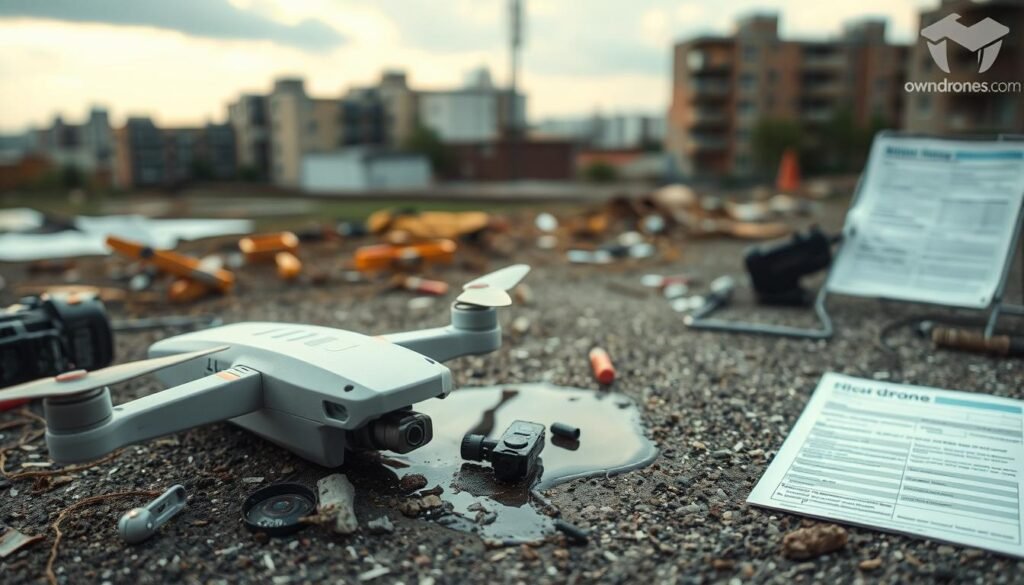
A California homeowner claims CSAA dropped her coverage after using a drone during renovations. She spent $200,000 on remodeling over three years. The homeowner was a CSAA customer for 40 years, paying $80,000 for insurance.
CSAA denied using drones but admitted to using aerial imagery. They stated third-party aircraft and satellites were used to assess properties.
High-Profile Drone Incidents
Recent drone accidents have made headlines, showing risks of unmanned aerial vehicles:
- An attacker in Arizona targeting law enforcement with drones received a 26-year sentence.
- A drone carrying explosives landed on the roof of La Roca maximum security prison in Ecuador.
- Langley Air Force Base in Virginia faced mysterious drone swarm incursions.
- Guerrillas in Columbia targeted soldiers by dropping a grenade from a drone, resulting in the death of a 10-year-old boy.
Drones in the Aviation Industry
The aviation industry has seen its share of drone-related incidents. Several close calls and collisions have been reported:
- Spirit Airlines Flight 1304 crew spotted a drone flying 300 feet below them at Baltimore/Washington International airport.
- Emirates Airbus A380 sustained wing damage after colliding with a drone at Nice Airport.
- Virgin Atlantic Boeing 787 Dreamliner narrowly avoided a collision with a drone after takeoff from Heathrow Airport.
- Air Force Eurofighter Typhoon collided with a drone while approaching to land at Manching military airport in Germany.
The Importance of Drone Insurance Coverage
These examples show why comprehensive drone insurance coverage is important. All pilots need the right insurance for peace of mind and financial protection. The drone industry keeps changing, so stay informed about drone insurance developments.
The Future of Drone Insurance in an Evolving Industry
The commercial drone market is growing rapidly. Experts predict 14% annual growth until 2030. By 2024, commercial use will surpass consumer use, driven by new technologies and applications.
Drones are transforming various sectors. These include agriculture, construction, and many others. This growth is changing the drone insurance landscape significantly.
Insurance companies are already using drones to improve operations. Allstate, for example, reduced repair estimate times to 4.5 days using drones. This integration has led to lower costs and better efficiency.
Drones enhance data collection accuracy. They can turn 2D images into 3D models with 1cm resolution. This technology is revolutionizing the insurance industry.
Adapting to New Technologies and Applications
Insurance providers must keep up with the latest drone developments. They need to offer coverage that meets the changing needs of pilots and operators. This includes addressing new challenges like cybersecurity concerns.
Hacking and hijacking drones can lead to data breaches and financial losses. Insurers must consider these risks when developing policies. They also need to navigate the legal landscape of drone use.
Flight restrictions and special permissions are required in certain areas. These include national parks, military bases, and airports. Privacy concerns from potential intrusions on private property also need addressing.
Potential Changes in Regulations and Insurance Requirements
As the drone industry grows, regulations and insurance requirements may change. Pilots and operators should stay informed about potential updates. These changes could affect their coverage needs.
Some countries have specific requirements. For example, Egypt requires permission from the Ministry of Defense for drone flights. Insurers must adapt to these varying regulations across different regions.
The future of drone insurance will likely be more comprehensive. It may integrate satellite data with drone technology for better risk assessment. This approach could improve claims management and overall efficiency.
Major insurers are already using drone and robotic technology successfully. These include Allianz, AXA, Munich Re, and State Farm. As more companies adopt these innovations, the industry will see improvements.
These advancements will lead to reduced costs and better customer experiences. The drone insurance landscape is set to evolve alongside the rapidly growing drone industry.
Conclusion
Drone insurance is vital as the industry grows. It protects your investment and provides peace of mind. The risk of accidents increases with drone use in various sectors.
Drone insurance covers accidental damage, payload loss, and legal fees. It’s crucial for financial security and operational safety. Comprehensive policies offer protection for many scenarios.
India’s legal landscape for drones is evolving rapidly. Insurance is key for compliance. Policies cover third-party liability, personal accidents, and specialized operations.
Premiums depend on drone type, use, pilot experience, and coverage limits. Chemical liability insurance starts at $300,000. General liability coverage begins at $100,000. Hull coverage is about 10% of equipment cost.
Real-world examples show how drone insurance mitigates financial losses. Commercial operators benefit from coverage for technical malfunctions. Hobbyists find relief in third-party liability protection.
Payload coverage helps aerial photographers recover costs of lost equipment. Staying informed about insurance options is crucial. Adapting to changing regulations ensures adequate protection for drone operations.
